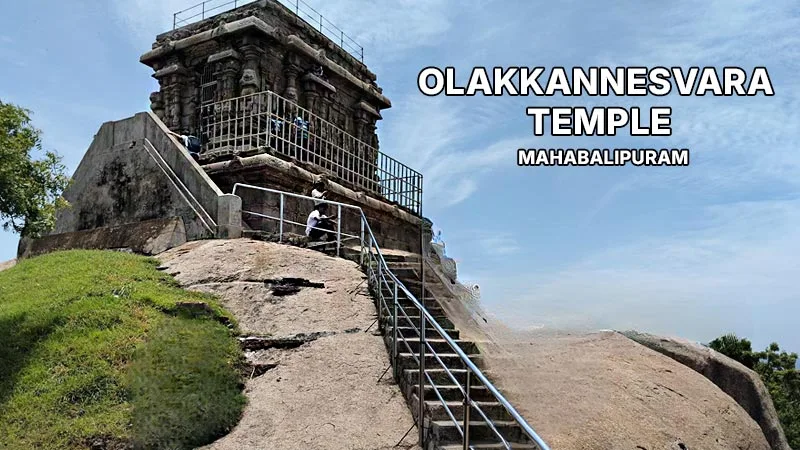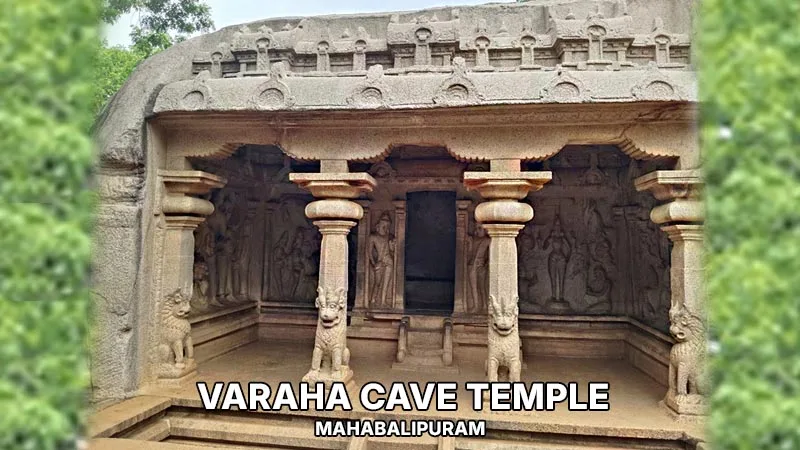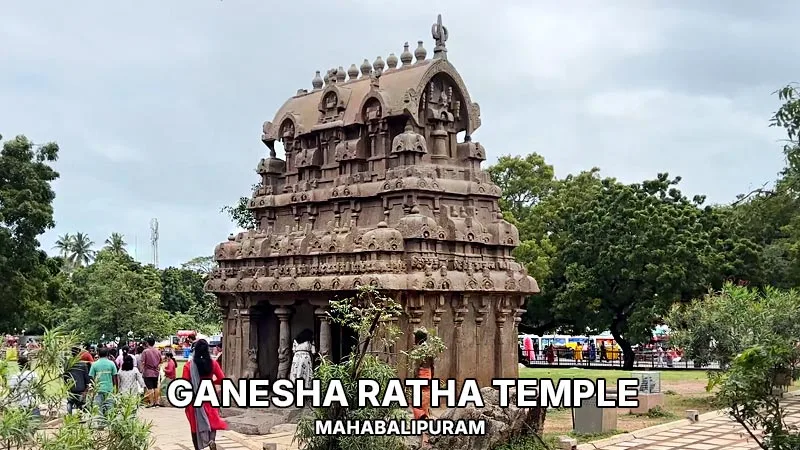The Olakkannesvara Temple, often called the Old Lighthouse Temple, is one of Mahabalipuram’s most intriguing monuments. Perched atop a hill overlooking the Bay of Bengal, this 8th-century marvel beautifully combines Pallava architecture and maritime history.
When I visited, I was struck not only by its commanding views of the coastline but also by its simplicity compared to the grander Shore Temple below. It felt like stepping into a forgotten chapter of Tamil Nadu’s history.
Contents
- Vital Visitor Information
- Why is Olakkannesvara Temple Called the Lighthouse Temple?
- History of Olakkannesvara Temple
- Why Visit Olakkannesvara Temple?
- Architecture and Design
- Timings and Entry Fee
- How to Reach Olakkannesvara Temple?
- Architecture and What I Observed
- What to Expect at Olakkannesvara Temple?
- My Personal Review
- Health and Safety
- Children’s Activities
- Photography Tips
- Visitor Information and Guidelines
- Nearby Attractions
Vital Visitor Information
| Information | Details |
|---|---|
| Location | Mahabalipuram, Tamil Nadu, India |
| Timings | 6:00 AM – 6:00 PM daily |
| Entry Fee | Free |
| Visit Duration | 30–45 minutes |
| Best Time to Visit | November – February (pleasant weather) |
| How to Reach | 1.5 km from Mahabalipuram Bus Station |
| Height | Situated atop a hill approx. 20 meters high |
| Museum Nearby | The New Lighthouse Museum is just 100 meters away |
| Significance | Dual-purpose shrine: Worship & maritime navigation |
| Why People Love It | Panoramic sea views, peaceful atmosphere |
Why is Olakkannesvara Temple Called the Lighthouse Temple?
The Olakkannesvara Temple earned the name “Lighthouse Temple” because it once served as both a shrine and a beacon for sailors. Built in the 8th century by Pallava king Rajasimha, fires were lit on its rooftop to guide ships navigating the Coromandel Coast.
Its hilltop location offered a clear view of the Bay of Bengal, making it the perfect spot for ancient mariners to spot from afar. Even today, the temple’s strategic position reminds visitors of its dual role in history.
History of Olakkannesvara Temple
This temple was built during the Pallava dynasty, most likely under the reign of Narasimhavarman II (Rajasimha) in the early 8th century.
Originally dedicated to Lord Shiva, the sanctum once housed a Shiva Lingam and served as a small shrine for Pallava sailors seeking divine protection before venturing into the Bay of Bengal.
By the 15th century, the sanctum was abandoned as a place of worship, but its strategic location made it useful as a lighthouse. Sailors would use the fire lit on the temple roof as a beacon, guiding them safely through the coastal waters long before modern lighthouses existed.
Today, while the temple no longer contains its deity, it stands as a silent sentinel of Mahabalipuram’s maritime heritage.
Why Visit Olakkannesvara Temple?
In my opinion, the charm of the Old Lighthouse Temple lies in its serenity and views. Unlike the crowded Shore Temple, this spot feels more like a retreat where you can sit quietly and take in the endless horizon.
Climbing the gentle slope to reach the temple, I noticed how its weathered granite walls seemed to merge with the rocky hill. And the panoramic views from the top—stretching over the Shore Temple, the vast sea, and the surrounding countryside—are worth every step.
It’s the perfect spot for history lovers, photographers, and anyone wanting to experience Mahabalipuram’s quieter side.
Architecture and Design
The Olakkannesvara Temple is a simple yet elegant structure, showcasing early Dravidian architecture.
- Sanctum Sanctorum: The sanctum is now empty but was originally dedicated to Lord Shiva.
- Granite Construction: Built from locally quarried stone, the temple’s weathered façade tells stories of centuries of sea winds and salt air.
- Lighthouse Function: A flat terrace above the sanctum was used to light fires at night, guiding ships along the Coromandel Coast.
When I explored the site, I couldn’t help but imagine ancient Pallava sailors glancing up at this hilltop beacon as they navigated treacherous waters.
Timings and Entry Fee
- Opening Hours: 6:00 AM – 6:00 PM (Daily)
- Entry Fee: Free for all visitors.
- Best Time for Photography: Early morning (sunrise) or late afternoon (sunset).
How to Reach Olakkannesvara Temple?
| Mode of Transport | Details |
|---|---|
| By Air | Nearest airport: Chennai International Airport (60 km). Taxis and buses available. |
| By Train | Nearest railway station: Chengalpattu Junction (30 km). Local buses and taxis to site. |
| By Road | From Chennai: Scenic East Coast Road (ECR) drive to Mahabalipuram, approx. 1.5 hours. |
| From Bus Station | The temple is 1.5 km from Mahabalipuram bus stand; can be reached on foot or by tuk-tuk. |
Architecture and What I Observed
The temple’s simple yet elegant Dravidian design stands out. Unlike other Mahabalipuram temples, this one is small and minimalistic, reflecting its dual purpose as both a shrine and a lighthouse.
The sanctum sanctorum no longer houses a deity, but as I stood inside, I felt the weight of centuries-old history. The view from the roof left me speechless—the Shore Temple looked majestic from this height, and I could see fishing boats dotting the horizon.
What to Expect at Olakkannesvara Temple?
During my visit, I found the climb to the temple to be an easy 10-minute walk. Once at the top, the breeze from the Bay of Bengal was refreshing, and the view of Mahabalipuram spread out below was spectacular.
Expect to spend 30–45 minutes exploring the site, taking photos, and enjoying the peaceful atmosphere.
My Personal Review
For me, the Olakkannesvara Temple was one of the most peaceful spots I experienced in Mahabalipuram.
As I walked up the gentle hill, the sound of the waves grew softer, replaced by the wind whispering through the stones.
Reaching the top, I paused to take in the sweeping views of the Bay of Bengal and the Shore Temple below—it felt like standing on the edge of history.
What struck me most was the simplicity of the temple. Unlike the grand carvings of other monuments, this place seemed to radiate quiet strength. I imagined the Pallava sailors centuries ago, relying on the fire that once burned atop this hill to guide them safely home.
This isn’t a site you rush through. I’d recommend finding a spot to sit and let the view sink in. There’s something meditative about being here, surrounded by ancient granite and endless sky.
It may not be as ornate as Mahabalipuram’s other wonders, but the sense of solitude and timelessness makes it unforgettable.
Health and Safety
- Stay Hydrated: Carry water, especially if visiting midday.
- Watch Your Step: The terrain is rocky and uneven in places.
- Sun Protection: Bring a hat, sunscreen, and sunglasses.
Children’s Activities
- Educational Stop: Teach kids about ancient lighthouses and maritime history.
- Exploration: The gentle climb is safe and fun for older children.
Photography Tips
- Golden Hours: Morning or evening light enhances the granite’s warm tones.
- Panoramic Shots: Capture the Shore Temple and Bay of Bengal from the hilltop.
- Close-Ups: Focus on the intricate carvings and textures of the stone.
Visitor Information and Guidelines
- Dress Code: Modest clothing recommended.
- Facilities: Limited restrooms nearby.
- Accessibility: The climb might be difficult for visitors with mobility issues.
Nearby Attractions
After visiting the Olakkannesvara Temple, you can explore:
- Shore Temple (visible from the top).
- Pancha Rathas (5 minutes away).
- Mahabalipuram Lighthouse Museum (next door to the temple).







